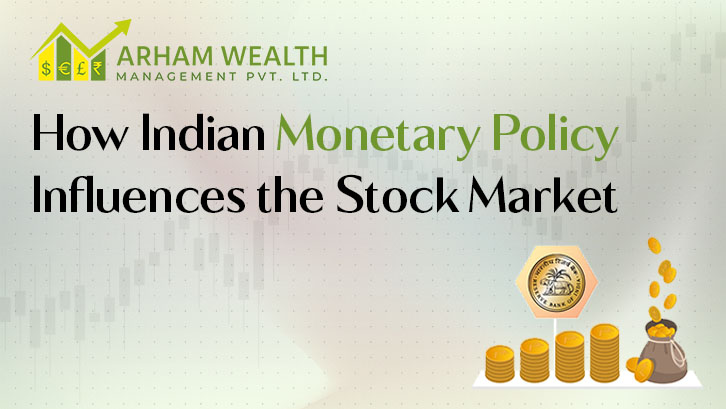


What if I told you the RBI doesn’t just control interest rates — it also silently steers the stock market?
Every few weeks, the Reserve Bank of India (RBI) sits down to review the economic pulse — inflation trends, growth projections, global cues, and liquidity flows. What follows is a decision that may seem technical on paper — like the recent 50 basis point cut in the repo rate to 5.5%, marking the third consecutive reduction — but it has real-world consequences for your investments.
Whether you’re a large institutional player or a first-time investor in Surat or Indore, these policy shifts can change the course of your portfolio overnight.
And that brings us to a powerful trend shaping India’s markets today — the Rise of Tier 2 and 3 Investors. As access to Demat accounts, financial education, and advisory services grows, more retail investors from smaller cities are entering the market. Yet, many of them overlook one key factor — monetary policy.
In fact, a common mistake new investors make is focusing only on individual stocks or news tips while ignoring how broader economic levers like RBI’s policy rates silently impact their investments.
This blog is your shortcut to understanding:
In this blog, we’ll break it all down for you in a simple way to understand Monetary policy. So let's dive in.
Monetary policy refers to the strategic process through which a country’s central bank — in India’s case, the Reserve Bank of India (RBI) — regulates the economy by controlling the supply of money and setting key interest rates. Think of it as the RBI’s toolkit for keeping the economy balanced, healthy, and moving in the right direction.
The main objectives of monetary policy include:
To achieve these goals, the RBI adjusts policy interest rates and manages liquidity, which is the availability of money in the banking system. These two levers allow the central bank to either stimulate the economy or cool it down, depending on the situation.
In short, monetary policy is not just about technical economic adjustments — it’s about managing the delicate balance between growth and stability. It plays a critical role in shaping everything from home loan EMIs to stock market rallies.
The Reserve Bank of India (RBI) is India’s central bank and the custodian of the country’s monetary stability. It crafts and executes India’s monetary policy through its Monetary Policy Committee (MPC), which meets every two months to review economic indicators and decide whether to tweak key interest rates.
The main objective of RBI’s monetary policy is price stability while supporting economic growth. The RBI uses various tools to maintain this balance, such as:
When the economy shows signs of overheating (high inflation), the RBI raises interest rates to slow it down. During slowdowns or recessions, it lowers rates to stimulate borrowing and investment.
Understanding a few core rates is essential to grasp how monetary policy affects the stock market. Let’s explore the big three:
The repo rate is the rate at which the RBI lends money to commercial banks when they face short-term liquidity issues. It’s the most critical tool in the RBI’s monetary policy arsenal.
The reverse repo rate is the rate at which the RBI borrows money from commercial banks. It is always lower than the repo rate.
This rate acts as a liquidity control mechanism and indirectly influences market sentiment.
The cash reserve ratio is the percentage of a bank’s total deposits that must be maintained with the RBI in cash form.
Unlike repo and reverse repo rates, CRR directly affects liquidity rather than interest rates.
Now that we understand what each rate does, let’s explore how monetary policy decisions influence the Indian stock market:
Changes in monetary policy directly impact investor psychology. A repo rate cut is generally seen as a positive sign for markets. It implies that the RBI wants to stimulate growth, which can boost company earnings. On the other hand, a rate hike could trigger a cautious or bearish tone.
Interest rates set the benchmark for borrowing costs. High interest rates increase capital costs for businesses, reducing profitability. Sectors like real estate, automobiles, and banking are highly sensitive to interest rate changes. This influences their stock performance.
Monetary policy controls the liquidity in the market. If liquidity tightens due to a rate hike or CRR increase, fewer funds are available for stock market investments. A liquidity boost, however, leads to increased activity in equities, especially among institutional investors.
Foreign Institutional Investors (FIIs) track RBI decisions closely. An attractive interest rate environment in India (compared to global peers) encourages capital inflows, boosting market sentiment. On the contrary, tight policies can trigger outflows and drag markets down.
Investors often rotate their capital between these sectors based on the direction of monetary policy.
India’s monetary policy is much more than an economic tool—it’s a signal to investors about the direction of the economy. Whether you're a trader, long-term investor, or mutual fund participant, staying informed about RBI rate decisions, repo rate changes, and liquidity conditions is crucial.
Even a 0.25% change in the repo rate can affect everything from your loan EMIs to Sensex movements.
For retail investors, the takeaway is simple: Always factor in the macroeconomic context before making investment decisions. Track the RBI's policy moves and anticipate how different sectors may respond.
The next time you hear that the RBI has changed the repo rate, you’ll know that it's more than a headline. It’s a signal that can impact your portfolio. The Indian stock market is deeply connected to the economy’s pulse, and monetary policy is one of the strongest indicators of where that pulse is headed.
If you're unsure how to align your investment strategy with changing interest rates and macroeconomic policies, consider partnering with experts. Arham Wealth helps investors across worldwide navigate market volatility with research-backed insights, customized portfolio planning, and seamless digital access. Whether you're starting out or scaling up, Arham Wealth can help you make informed, goal-oriented financial decisions.
Stay informed. Stay invested. Stay ahead.